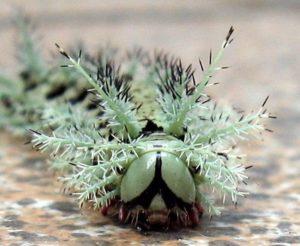Lonomia caterpillar (Lonomia obliqua): the most poisonous and inconspicuous caterpillar
Not everyone knows that poisonous caterpillars exist. Lonomia is a representative of a dangerous genus. Meeting with an insect is fraught with health problems.
Description of the Lonomia caterpillar
Name: lonomy
Latin: LonomyClass: Insects - Insecta
Squad: Lepidoptera - Lepidoptera
Family: Peacock-eyes - Saturniidae
 | Habitats: | tropics and subtropics |
 | Dangerous for: | people and animals |
 | Features: | the most dangerous genus of caterpillars |
The most dangerous caterpillars are representatives of the genus Lonomy. They have a deadly venom on their spines, a strong, natural toxin. Brownish-green coloration helps to camouflage. Sometimes they merge with the bark of trees.
Brighter individuals can also remain invisible, because they find themselves the most inconspicuous place. Color ranges from beige to light orange and pink. The structure is identical to fleece fabric or plush.
Later it becomes a harmless butterfly belonging to the peacock-eye family. The wings are usually open. Length within 4,5 - 7 cm.
Habitat and lifestyle
Lonomia is a heat-loving insect. They live in:
- Brazil
- Uruguay;
- Paraguay;
- Argentina.
Insects prefer peach, avocado, pear in food.
The life expectancy of a caterpillar is small - 14 days.
Caterpillars are afraid of sunlight and seek a secluded corner in the shade. Moisture is another important criterion for normal development.
Lonomy is difficult to detect. In this regard, people can touch a tree or foliage without paying attention to it.
Individuals create colonies, there is a possibility of collision with several insects.
Caterpillars are dangerous due to the content of the most powerful toxin, which in the human body can cause irritation. Even death is possible.
The danger of lonomy
Growths similar to spruce branches are very dangerous. They contribute to the penetration of dangerous poison into the circulatory system. It is known that insects can sting. Predators die from this poison, but the outcome of people is different.
With one touch, a sharp thorn pricks and the poison begins to spread. The most common consequences are cerebral hemorrhages and internal bleeding.
Only this species has this level of toxicity.
This can be counteracted by administering an antidote.. It neutralizes toxins. The difficulty lies in the fact that a person does not always consider lonomy dangerous. However, the symptoms can progress rapidly and cause lonomiasis. In this case, problems cannot be avoided.
The first incident was recorded in Rio Grande de Sol. Farmers were diagnosed with an epidemic in 1983. All had burns and spots similar to gangrene. It is worth noting that the number of deaths is 1,7% of all those stung. This is 0,1% less than from rattlesnake bites.
In nature, there is a number of beautiful but dangerous caterpillars.
Conclusion
In the wild, there are not only dangerous animals, but also insects. When traveling to a number of countries, it is necessary to avoid contact with lonomia.

